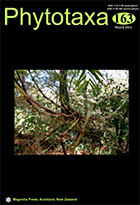Abstract
Three new species of Monochaetum (Melastomataceae: Melastomeae) are described from Colombia. Monochaetum carbonoi, known only from the Sierra Nevada de Santa Marta, is characterized by its overall pubescence of smooth and unbranched trichomes, prominent flap-like scars on the inflorescence nodes, calyx lobes that are deciduous after anthesis, glabrous hypanthia, dimorphic stamens, and sessile, oblong-ovate bracteoles. Monochaetum longicaudatum, known from only one population on the eastern flank of the Sierra Nevada de Santa Marta, and one population in the Central Cordillera of the Andes (Nevado del Ruíz and Santa Isabel area), is characterized by its dense and congested inflorescences, abaxial foliar surface with dense, long and divergent trichomes, ovate to ovate-elliptic petals with a broadly acute apex, deciduous calyx lobes, long filaments and appendages on the antesepalous stamens, and its long setulose style. Monochaetum perijensis, known only from the Serranía de Perijá in the northern Cordillera Oriental of the Andes, is characterized by leaves that are basally nerved, glabrous hypanthia, ciliate petals, and persistent calyx lobes that are oblong and acute apically. Each species is illustrated, compared with presumed relatives, and provided with a conservation assessment using IUCN guidelines.

